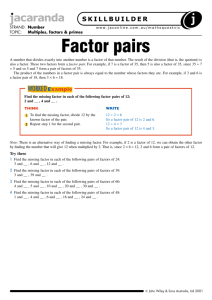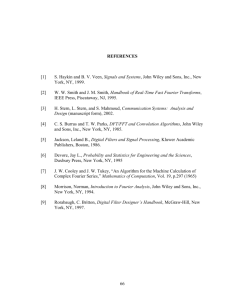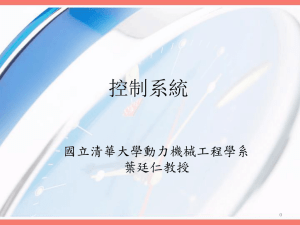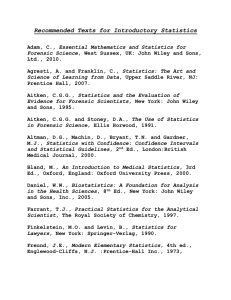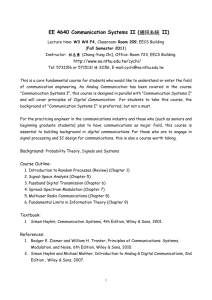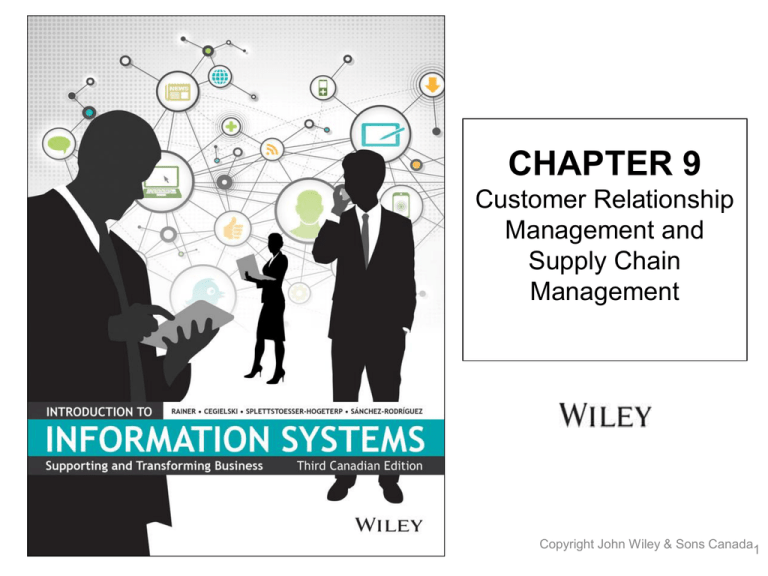
CHAPTER 9
Customer Relationship
Management and
Supply Chain
Management
Copyright John Wiley & Sons Canada1
Chapter 9:
Customer Relationship Management and
Supply Chain Management
9.1 Defining Customer Relationship
Management
9.2 Operational Customer Relationship
Management Systems
9.3 Analytical Customer Relationship
Management Systems
9.4 Other Types of Customer Relationship
Management Systems
9.5 Supply Chains
9.6 Supply Chain Management
9.7 Information Technology Support for Supply
Chain Management
Copyright John Wiley & Sons Canada
2
LEARNING OBJECTIVES
1. Define “customer relationship management” and
“collaborative CRM”, and identify the primary functions
of both processes.
2. Describe the two major components of operational CRM
systems, list three applications used in each
component, and provide at least one example of how
businesses use each application.
3. Describe “analytical CRM systems”, and describe four
purposes for which businesses use these systems.
Copyright John Wiley & Sons Canada
3
LEARNING OBJECTIVES
(CONTINUED)
4. Define “mobile CRM systems”, “on-demand CRM
systems”, and “open-source CRM systems”, and
identify one main advantage and one main drawback of
each.
5. Define the term, “supply chain”, and describe the three
components and the three flows of a supply chain.
Copyright John Wiley & Sons Canada
4
LEARNING OBJECTIVES
(CONTINUED)
6. Identify two major challenges in setting accurate
inventory levels throughout the supply chain, and
describe three popular strategies to solve supply chain
problems.
7. Define “electronic data interchange (EDI)”, “extranet”,
and “portal”, and explain how each of these applications
helps support supply chain management.
Copyright John Wiley & Sons Canada
5
CASE 9.1 THE NEXT STEP IN
CUSTOMER RELATIONSHIP
MANAGEMENT
•
•
Taste profiling is when websites track what you buy or
look at and remember your tastes.
Persuasion profiling tries to guess what will persuade
you to buy something. Persuasion profiling can provide
many benefits but also has drawbacks. To prevent
advertisers from pouncing on your personal
psychological weak spots, you should watch for signs of
persuasion profiling and view all marketing arguments
with a grain of salt.
Copyright John Wiley & Sons Canada
6
CASE 9.1 THE NEXT STEP IN
CUSTOMER RELATIONSHIP
MANAGEMENT
What We Learned From the Case
– It provides a specific example of the evolving nature of the
business-customer relationship.
– As personal technology usage changes, so too must the
methods that businesses use to interface with their customers.
– Organizations increasingly are emphasizing a customer-centric
approach to their business practices.
Copyright John Wiley & Sons Canada
7
9.1 DEFINING CUSTOMER
RELATIONSHIP MANAGEMENT
•
Customer relationship management (CRM) is a customer-focused
and customer-driven organizational strategy.
– Returns to personal marketing rather than market to a mass of
people or companies, businesses market to each customer
individually.
– Companies can implement a crm tool that manages e-mail
distribution, scheduling, billing, and customer information.
– Is not a process or a technology per se; rather, it is a customercentric way of thinking and acting.
– Helps companies acquire new customers, retain existing
profitable customers, and grow relationships with existing
customers.
Copyright John Wiley & Sons Canada
8
FROM NEIGHBORHOOD
STORES…….
•
•
•
Before the supermarket, the mall, and the automobile,
people purchased goods at their neighbourhood store.
The owners and employees recognized customers by
name and knew their preferences and wants.
For their part, customers remained loyal to the store
and made repeated purchases.
Copyright John Wiley & Sons Canada
9
TO TODAY…..
•
•
Over time personal customer relationship became
impersonal as people moved from farms to cities,
consumers became mobile, and supermarkets and
department stores achieved economies of scale through
mass marketing.
Although prices were lower and products were more
uniform in quality, the relationship with customers
became nameless and impersonal.
Copyright John Wiley & Sons Canada
10
FIGURE 9.1 THE CRM PROCESS
Copyright John Wiley & Sons Canada
11
9.1 IT’S ABOUT BUSINESS
AN INSTANTANEOUS CRM EFFORT
•
•
•
•
Social media presented an easy opportunity to make
the most of the customer experience and to
demonstrate to the organization that there is “gold” in
tweets
Systematically monitors what customers are saying on
social networking sites
Makes improvements when patrons have been unhappy
Companies ignore social media at their peril
Copyright John Wiley & Sons Canada
12
FIGURE 9.2 CUSTOMER TOUCH
POINTS
Copyright John Wiley & Sons Canada
13
DATA CONSOLIDATION
•
Data Consolidation = 360-Degree View of Customers
Copyright John Wiley & Sons Canada
14
9.2 OPERATIONAL CUSTOMER
RELATIONSHIP MANAGEMENT
SYSTEMS
•
Two major components of Operational CRM:
– Customer-facing applications: an organization’s sales, field
service, and customer interaction centre representatives interact
directly with customers
– Customer-touching or electronic CRM (e-CRM) applications:
customers interact directly with these technologies and
applications
Copyright John Wiley & Sons Canada
15
CUSTOMER-FACING
APPLICATIONS
•
•
•
•
Customer service and support
Sales force automation
Marketing
Campaign management
Copyright John Wiley & Sons Canada
16
MARKETING
•
•
•
Cross selling
Up selling
Bundling
Copyright John Wiley & Sons Canada
17
IT’S ABOUT BUSINESS 9.2
CHINATRUST PHILIPPINES CRM
EFFORT
•
•
•
•
Implemented new CRM system to record all customer
interactions
Sales agents can now access and analyze customers’
transaction history and use appropriate strategies for
targeting customers more effectively, including up and
cross-selling
Call agents have access to customer data at their
fingertips
Call service levels (calls answered within 10 seconds)
were drastically improved from 35 percent to 85 percent
Copyright John Wiley & Sons Canada
18
CUSTOMER-TOUCHING
APPLICATIONS
•
•
•
•
•
•
•
•
Search and Comparison Capabilities
Technical & Other Information Services
Customized Products & Services
Personalized Web Pages
FAQ’s
E-mail & Automated Response
Loyalty Programs
Click on the links to review examplesof customer
touching applications
Copyright John Wiley & Sons Canada
19
BENEFITS OF OPERATIONAL CRM
SYSTEMS
•
•
•
•
Provide efficient, personalized marketing, sales, and
service.
Get a 360-degree view of each customer.
Give sales and service employees access to a complete
history of customer interaction with the organization
Improve sales and account management
Copyright John Wiley & Sons Canada
20
BENEFITS OF OPERATIONAL CRM
SYSTEMS (CONTINUED)
•
•
•
•
•
Form individualized relationships with customers
Identify the most profitable customers
Provide employees with the information and processes
necessary to know their customers.
Understand and identify customer needs
Effectively build relationships among the company, its
customer base, and its distribution partners.
Copyright John Wiley & Sons Canada
21
9.3 ANALYTICAL CUSTOMER
RELATIONSHIP MANAGEMENT
SYSTEMS
•
•
•
•
•
Analytical CRM systems analyze customer data for a
variety of purposes:
designing and executing targeted marketing campaigns
increasing customer acquisition, cross selling, and up
selling
providing input into decisions relating to products and
services
providing financial forecasting and customer profitability
analysis
Copyright John Wiley & Sons Canada
22
FIGURE 9.3 THE RELATIONSHIP
BETWEEN OPERATIONAL CRM AND
ANALYTICAL CRM
Copyright John Wiley & Sons Canada
23
IT’S ABOUT BUSINESS 9.3
REFINING THE CALL CENTRE
ELoyalty software identified six personality types:
•
•
•
Emotions-driven (30%):forge
relationships with agents
before getting into the
problem.
Thoughts-driven (25%): want
facts and analysis and are
not fond of small talk.
Reactions-driven (20%):
either love something or hate
it.
• Opinions-driven (10%):
customers’ language is
full of imperatives, their
minds are made up.
• Reflections-driven (10%):
introverts who live in their
own worlds, prefer
silence to banter, and
often skip personal
pronouns in their speech.
• Actions-driven (5%):
want movement and
progress.
Copyright John Wiley & Sons Canada
24
9.3 IT’S ABOUT BUSINESS
REFINING THE CALL CENTRE
•
Pairing callers with like-minded representatives offers
four benefits to companies:
– Saves them a great deal of money
– Enables company representatives to resolve issues for more
customers
– Increases customer satisfaction
– Reduces customer churn (turnover)
Copyright John Wiley & Sons Canada
25
9.4 OTHER TYPES OF CUSTOMER
RELATIONSHIP MANAGEMENT
SYSTEMS
•
•
•
•
On-demand
Mobile
Open-source
Click on the links to examples of customer relationship
management vendors
Copyright John Wiley & Sons Canada
26
9.5 SUPPLY CHAINS
•
Supply chain is the flow of materials, information,
money, and services from raw material suppliers,
through factories and warehouses, to the end
customers; it includes the organizations and
processes that create and deliver products,
information, and services to end customers.
Copyright John Wiley & Sons Canada
27
FIGURE 9.4 GENERIC SUPPLY
CHAIN
Copyright John Wiley & Sons Canada
28
FLOWS OF THE SUPPLY CHAIN
•
•
•
Material: physical products, raw materials, supplies,
etc. that flow along the chain
Information: data related to demand, shipments,
orders, returns, and schedules, as well as changes in
any of these data
Financial: money transfers, payments, credit card
information and authorization, payment schedules, epayments, and credit-related data.
Copyright John Wiley & Sons Canada
29
9.6 SUPPLY CHAIN MANAGEMENT
•
•
Supply chain management (SCM)
Interorganizational information system (IOS)
Copyright John Wiley & Sons Canada
30
INTERORGANIZATIONAL
INFORMATION SYSTEM (IOS)
•
•
•
•
•
Reduces costs of routine business transactions
Improves quality of information flow by reducing or
eliminating errors
Compresses cycle time in fulfilling business
transactions
Eliminates paper processing and its associated
inefficiencies and costs
Makes transfer and processing of information easier for
users
Copyright John Wiley & Sons Canada
31
PUSH MODEL
•
Push model, also known as make-to-stock, the
production process begins with a forecast, which is
simply an educated guess as to customer demand.
Copyright John Wiley & Sons Canada
32
PULL MODEL
•
Pull model, also known as make-to-order, the
production process begins with a customer order.
Copyright John Wiley & Sons Canada
33
PROBLEMS ALONG THE SUPPLY
CHAIN
•
•
•
•
Poor customer service
Poor quality product
High inventory costs
Loss of revenues
Copyright John Wiley & Sons Canada
34
FIGURE 9.5 THE BULLWHIP
EFFECT
Copyright John Wiley & Sons Canada
35
SOLUTIONS TO SUPPLY CHAIN
PROBLEMS
•
•
Vertical Integration
Using Inventories
– Just-in-time
•
Information Sharing
– Vendor-managed inventory (VMI)
Copyright John Wiley & Sons Canada
36
9.7 INFORMATION TECHNOLOGY
SUPPORT FOR SUPPLY CHAIN
MANAGEMENT
•
•
•
Electronic Data Interchange (EDI)
Extranets
Web Services
Copyright John Wiley & Sons Canada
37
EDI BENEFITS
•
•
•
•
•
•
•
Minimize data entry errors
Length of messages are shorter
Messages are secured
Reduces cycle time
Increases productivity
Enhances customer service
Minimizes paper usage and storage
Copyright John Wiley & Sons Canada
38
EDI LIMITATIONS
•
•
•
Sometimes business processes must be restructured
EDI is being replaced by XML-based web services
Multiple EDI standards exist
Copyright John Wiley & Sons Canada
39
FIGURE 9.6 COMPARING PURCHASE
ORDER FULFILLMENT WITH AND
WITHOUT EDI
Copyright John Wiley & Sons Canada
40
EXTRANETS
•
Major benefits:
–
–
–
–
–
Faster processes
Information flow
Improved order entry and customer service
Lower costs
Overall improved business effectiveness
Copyright John Wiley & Sons Canada
41
FIGURE 9.7 THE STRUCTURE OF
AN EXTRANET
Copyright John Wiley & Sons Canada
42
EXTRANETS
•
There are 3 basic types of extranets
– A single company
– An entire industry
– Joint ventures and other business partnerships
•
There are 2 corporate portals:
– Procurement (sourcing)
– Distribution
Copyright John Wiley & Sons Canada
43
CHAPTER CLOSING
•
•
Customer relationship management (CRM) is an
organizational strategy that is customer focused and
customer driven.
Collaborative CRM is an organizational CRM strategy
where data consolidation and the 360-degree view of
the customer enable the organization’s functional areas
to readily share information about customers.
Copyright John Wiley & Sons Canada
44
CHAPTER CLOSING (CONTINUED)
•
•
•
Two major components of operational CRM systems:
customer-facing CRM, customer-touching
applications.
Analytical CRM systems analyze customer behaviour
and perceptions in order to provide business
intelligence.
Three additional CRM systems: mobile, on-demand,
and, open-source
Copyright John Wiley & Sons Canada
45
CHAPTER CLOSING (CONTINUED)
•
Supply chain is the flow of materials, information,
money, and services from raw material suppliers,
through factories and warehouses, to the end
customers.
–
–
–
–
three components: upstream, internal, downstream
three flows: material, information, financial
Two major challenges: demand forecast, bullwhip effect
three popular solutions: building inventories, just-in-time (JIT),
vendor-managed inventory (VMI)
Copyright John Wiley & Sons Canada
46
CHAPTER CLOSING (CONTINUED)
•
•
•
Electronic data interchange (EDI) is a communication
standard that enables the electronic transfer of routine
documents, such as purchasing orders, between
business partners.
Extranets are networks that link business partners over
the Internet.
Corporate Portals offer a single point of access
through a web browser to critical business information
in an organization.
Copyright John Wiley & Sons Canada
47
Copyright
Copyright © 2014 John Wiley & Sons Canada, Ltd. All rights
reserved. Reproduction or translation of this work beyond
that permitted by Access Copyright (the Canadian copyright
licensing agency) is unlawful. Requests for further
information should be addressed to the Permissions
Department, John Wiley & Sons Canada, Ltd. The purchaser
may make back-up copies for his or her own use only and
not for distribution or resale. The author and the publisher
assume no responsibility for errors, omissions, or damages
caused by the use of these files or programs or from the use
of the information contained herein.

